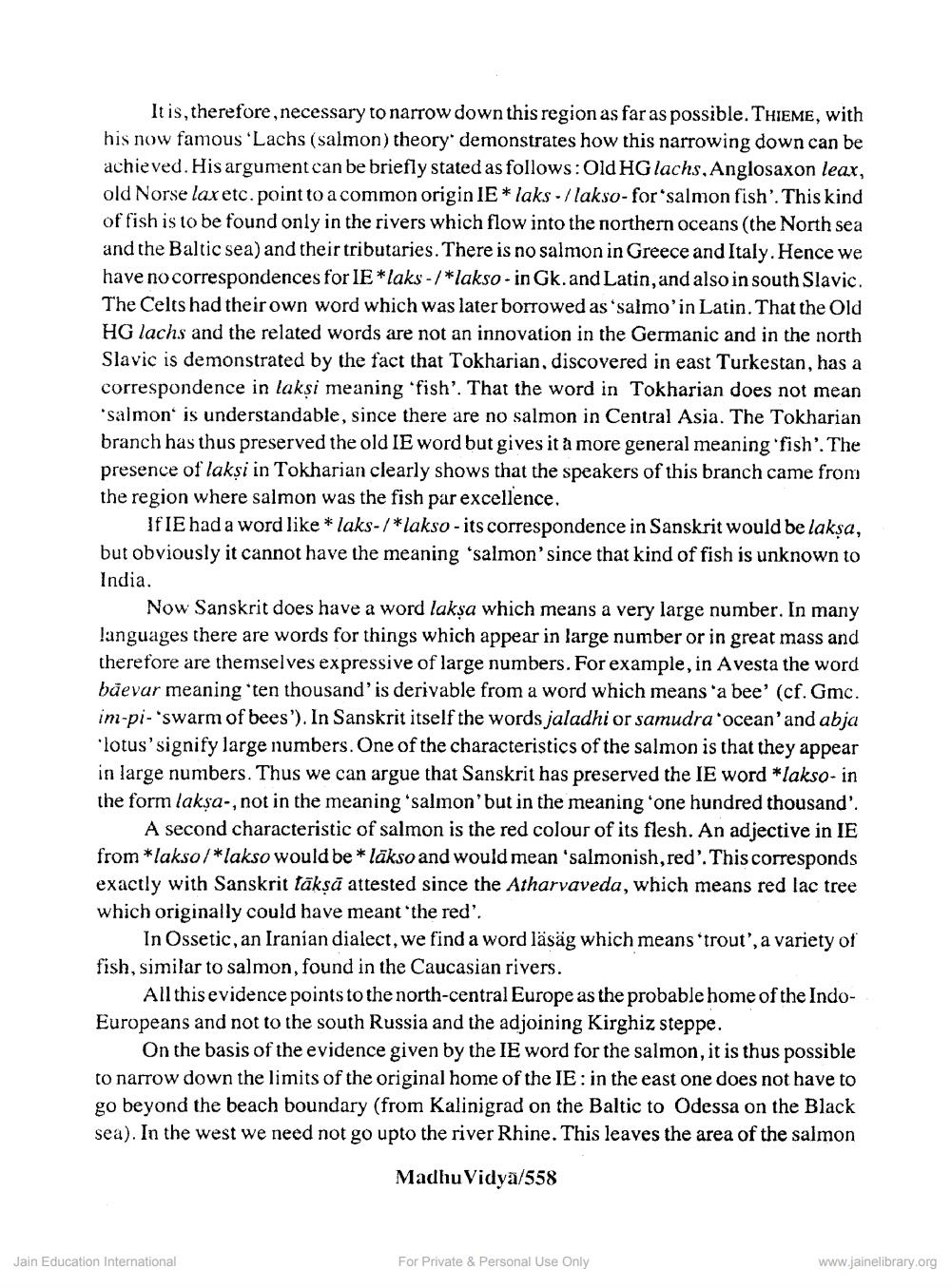________________
It is, therefore, necessary to narrow down this region as far as possible. THIEME, with his now famous 'Lachs (salmon) theory demonstrates how this narrowing down can be achieved. His argument can be briefly stated as follows: Old HG lachs, Anglosaxon leax, old Norse lax etc. point to a common origin IE * laks -/lakso- for salmon fish'. This kind of fish is to be found only in the rivers which flow into the northern oceans (the North sea and the Baltic sea) and their tributaries. There is no salmon in Greece and Italy. Hence we have no correspondences for IE *laks-/*lakso - in Gk.and Latin, and also in south Slavic. The Celts had their own word which was later borrowed as'salmo'in Latin. That the Old HG lachs and the related words are not an innovation in the Germanic and in the north Slavic is demonstrated by the fact that Tokharian, discovered in east Turkestan, has a correspondence in lakși meaning 'fish'. That the word in Tokharian does not mean 'salmon is understandable, since there are no salmon in Central Asia. The Tokharian branch has thus preserved the old IE word but gives it à more general meaning fish'. The presence of lakṣi in Tokharian clearly shows that the speakers of this branch came from the region where salmon was the fish par excellence.
FIE had a word like * laks-/*lakso - its correspondence in Sanskrit would be laksa, but obviously it cannot have the meaning 'salmon'since that kind of fish is unknown to India.
Now Sanskrit does have a word lakṣa which means a very large number. In many languages there are words for things which appear in large number or in great mass and therefore are themselves expressive of large numbers. For example, in Avesta the word bäevar meaning ten thousand' is derivable from a word which means a bee' (cf. Gmc. im-pi-'swarm of bees'). In Sanskrit itself the words jaladhi or samudra'ocean'and abja 'lotus'signify large numbers. One of the characteristics of the salmon is that they appear in large numbers. Thus we can argue that Sanskrit has preserved the IE word *lakso- in the form lakṣa-, not in the meaning 'salmon'but in the meaning one hundred thousand'.
A second characteristic of salmon is the red colour of its flesh. An adjective in IE from *lakso/*lakso would be *läkso and would mean 'salmonish,red'. This corresponds exactly with Sanskrit taksā attested since the Atharvaveda, which means red lac tree which originally could have meant 'the red'.
In Ossetic, an Iranian dialect, we find a word läsäg which means 'trout', a variety of fish, similar to salmon, found in the Caucasian rivers.
Allthis evidence points to the north-central Europe as the probable home of the IndoEuropeans and not to the south Russia and the adjoining Kirghiz steppe.
On the basis of the evidence given by the IE word for the salmon, it is thus possible to narrow down the limits of the original home of the IE: in the east one does not have to go beyond the beach boundary (from Kalinigrad on the Baltic to Odessa on the Black sea). In the west we need not go upto the river Rhine. This leaves the area of the salmon
Madhu Vidya/558
Jain Education International
For Private & Personal Use Only
www.jainelibrary.org




